Winter 2018 Newsletter

Quick Content Links
- President’s Message
- NCAFS 2019 President-Elect Ballot
- Save the Date – NCAFS 2019 Annual Meeting!
- NCAFS Treasurer’s Report as of 12/18/2018
- NCSU Student Fisheries Society Update
- Environmental Concerns Committee Announcement
- News from the NCAFS Awards Committee
- Frank Joseph Schwartz Obituary
- Telemetry Study Documents Atlantic Sturgeon Movement to Blewett Falls Dam
- Other Notable Recent Atlantic Sturgeon Records
- News from NCWRC
- Call to Action!
- Valuable Links
President’s Message
On behalf of the NCAFS EXCOM, I hope that everyone had a memorable holiday and enjoyed the opportunity to spend time with family and friends! As we enter a new year, I’m sure many of you are hopeful that 2019 will bring less rainfall and the opportunity to complete fieldwork without the stress of unfavorable sampling conditions. It is also a great time of year to reassess your research goals and how to achieve them with greater efficiency. Furthermore, it provides us with the opportunity to establish new partnerships that can strengthen our ability manage aquatic resources within North Carolina.
As we enter a new year, I encourage you to get involved in AFS. You can help at many levels (National, Division, State, and Student Subunits) and play an active role by attending meetings, serving on committees or an EXCOM, reviewing manuscripts, submitting newsletter articles, voting during society elections, mentoring students, or volunteering to help with meeting planning and setup. As our Annual Chapter Meeting approaches, EXCOM and volunteers have been working hard to ensure that we have a successful meeting, however, there is often a need for additional help (e.g., moderators, presentation loading, or AV assistance). If you are new to AFS or an Old Salt AFS member, please consider getting or staying involved in 2019.
It is hard to believe that my tenure as NCAFS President will be coming to an end and I will be transitioning into my role as past-president. It has certainly been an honor to serve the NCAFS Chapter over the past two years! I have truly enjoyed the opportunity to work with EXCOM, committee members, and our membership. In addition, I am excited to announce that the Nominations Committee has selected President-Elect candidates. Please take the time to review the nominations in the newsletter and cast your vote!
See you in 2019!
Submitted by Tyler Black, NCAFS President
NCAFS 2019 President-Elect Ballot
The Nominations Committee is pleased to present the 2019 NCAFS ballot for President-Elect. Chapter members running for President-Elect are Tom Fox and Ben Ricks. Please take a moment to evaluate the candidate sketches and cast your vote on the electronic ballot:
Click here to access the 2019 NCAFS ballot
Remember only the votes of current paid members will be counted during the election (click here to join/pay dues). Poll closes at midnight, February 1st, 2019 and results will be announced at the 2019 NCAFS Business Meeting in Winston-Salem, NC on February 21st. Those who vote will be entered into a drawing for a 2019 AFS Parent Society membership (a $95 value).
Good luck to each candidate!
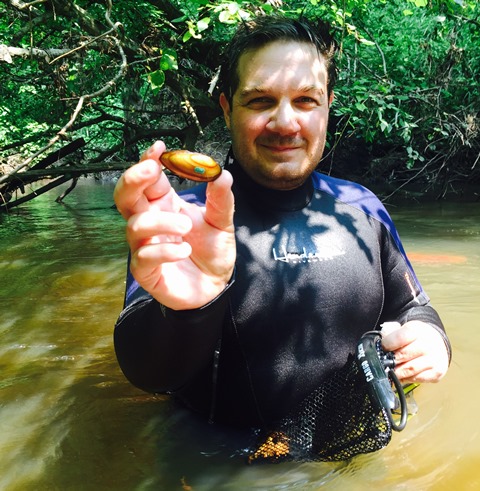 Tom Fox
Tom Fox
Senior Biologist
CALYX Engineers and Consultants – An NV5 Company, Cary, NC
Tom Fox is a Senior Biologist with CALYX Engineers and Consultants – An NV5 Company, where he has worked since July 2018. In his new role, Tom conducts fish and freshwater mussel surveys targeting threatened and endangered species throughout NC. For the previous 4 years, he focused his efforts on bolstering rare mussel populations and updating the status of several fish and mussel species across five river basins in northeastern NC while he served as the Eastern Region Aquatic Wildlife Diversity Biologist with the NCWRC. Throughout the years, Tom has held several positions with NCWRC and NC State University, including District 3 Assistant Fisheries Biologist, Research Associate, Lab Manager, and Creel Clerk. He received his B.S. in Biology from George Washington University and M.S. in Fisheries, Wildlife, and Conservation Biology from NC State University. Tom has been an NCAFS member since 2010 and has served on the program committee and as a presentation judge in past chapter meetings. In his free time, Tom enjoys fishing, hiking, and camping with his wife and dog.
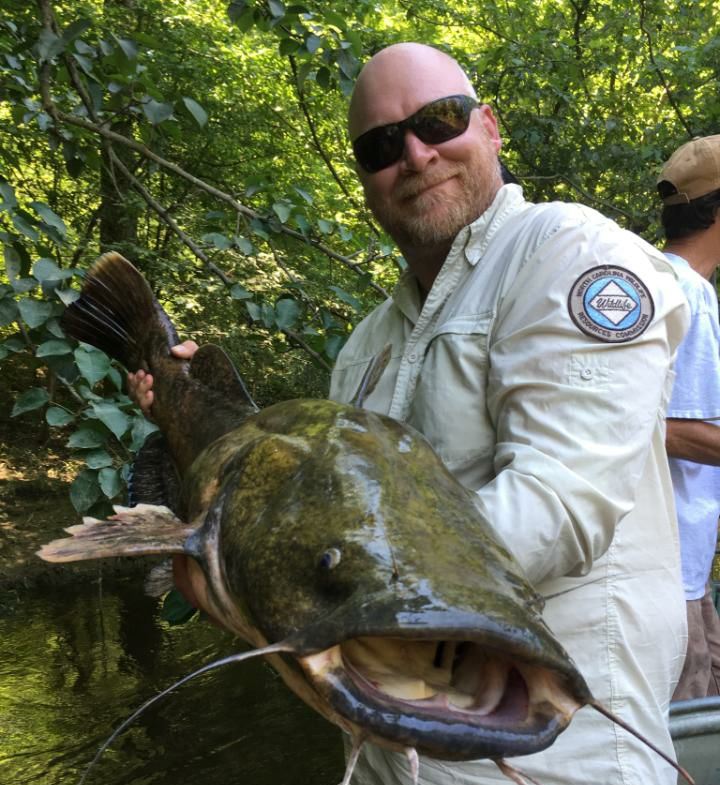 Ben Ricks
Ben Ricks
District 2 Fisheries Biologist
NC Wildlife Resources Commission
A native of Roanoke Rapids, NC, Ben grew up on his family’s farm hunting and fishing. It was his love for fishing that drove him to a career in fisheries management. Ben was fascinated by anadromous fish and their migration patterns at an early age. After earning a degree in education from NC State University, he went to Auburn University for a M.S. in Fisheries. After graduation Ben took a job with Alabama Wildlife and Freshwater fisheries for a few years before moving back to NC. He started with the Commission in District 1. It was an amazing experience being the biologist over all the waters he grew up fishing. Now Ben is the District 2 Fisheries Biologist. He lives north of New Bern with his amazing wife Heidi. They attend Two Rivers Church and are active there. Ben fishes or hunts nearly all his time off. His family still has a farm in Northampton County where they are very active in wildlife habitat management and have won several stewardship awards. When not working he is at the farm or fishing. Ben is also a USCG certified captain. He fishes tournaments for Redfish, Spotted Sea Trout, Flounder, and Striped Bass. Ben is very passionate about natural resources conservation and enjoys his career.
Save the Date – NCAFS 2019 Annual Meeting!
When: February 19-21, 2019
Where: Winston-Salem
Meeting Site: The Historic Brookstown Inn www.brookstowninn.com
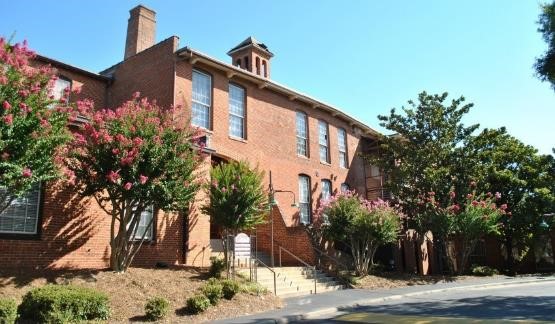
Schedule
Tuesday, Feb. 19th
- 10:00 am – 5:00 pm: NC Mollusk Working Group Meeting (Rachael Hoch, contact organizer for details)
- 7:00 – 10:00 pm: Social
Wednesday, Feb. 20th
- 8:00 – 11:30 am: Aquatic Nuisance Species Workshop
- 7:30 am – 6:00 pm: Registration Open
- 12:30 – 5:45 pm: Oral Presentations
- 7:00 – 10:00 pm: Poster Presentations/Dinner/Raffle
Thursday, Feb. 21st
- 8:00 am – 12:30 pm: Oral Presentations
- 1:45 – 3:30 pm: NCAFS Business Meeting/Awards
Please visit the 2019 NCAFS meeting webpage for more information.
NCAFS Treasurer’s Report as of 12/18/2018
1. NCAFS checking – $7,588.52;
2. NCAFS PayPal — $99.82;
3. NCAFS Edward Jones General Fund –$47,406.97;
4. NCAFS Edward Jones Ichthus Fund or Student Fund – $27,686.43;
5. Robust Redhorse Conservation Committee – $10,099.95;
In October, NCAFS donated $500 to Ashe County Friends of the Library to purchase water quality testing equipment and sampling gear for an aquatic conservation program lead by Ashe County Public Library. This program gives children hands-on experience in surveying and learning about the outside world. We look forward to hearing how the program inspired young and hopeful future conservationists! We also received our membership dues and annual rebate from AFS, a total of $1,153.35.
Just a reminder, if you have not already paid your membership fee of $15, you can do so in the following ways:
1. Online with your registration for the meeting
2. Online through our website anytime (online membership form here)
3. Through AFS when you renew your AFS membership
4. Via mail by sending the membership form and a check or cash (preferably check) – mailing information provided on the membership form
5. In person at the meeting via cash or check
If you renewed your membership before September 1, 2018, those dues were counted for the 2018 calendar year and you will still owe dues for 2019. If you have any questions about the renewal process or whether you have already renewed for the 2019 membership year please don’t hesitate to contact me ([email protected] or 336-290-0052). Hope to see you all at the meeting!
Submitted by Kelsey Lincoln, NCAFS Secretary/Treasurer
Note – Big thanks to Kelsey for agreeing to serve a second term as NCAFS Secretary/Treasurer!!!
NCSU Student Fisheries Society Update
The NC State University Student Fisheries Society had a fruitful fall semester. We made an effort to recruit more undergraduates to join our ranks, and had a full room for every meeting! With so many new faces, we had a meet and greet for our September meeting to introduce our organization and learn about all the new faces. We hosted two speakers at meetings this fall. In October, Todd Ewing (Aquatic Wildlife Diversity Supervisor, NC Wildlife Resources Commission) gave a talk entitled, “Tips for Getting Hired as a Fisheries Biologist with the NCWRC,” and at our November meeting, Dr. Ryan Emanuel (Associate Professor, NC Department of Forestry and Environmental Resources) presented, “Water in the Native World: North Carolina’s Indigenous Peoples in an Era of Global Change.” Attendees found both talks very informative and engaging! We thank Todd and Ryan for giving an evening of their time to the Student Fisheries Society.
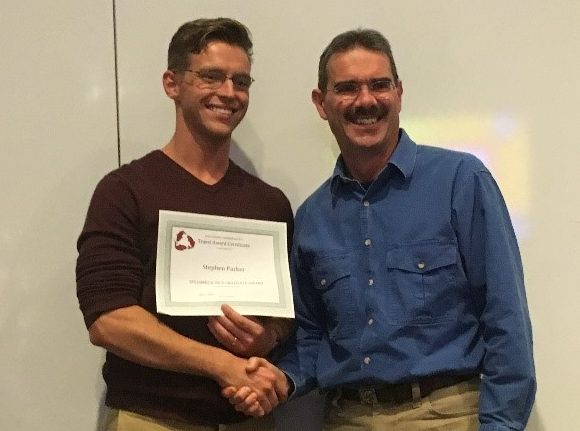
Stephen Parker receiving the inaugural James A. Rice Graduate Student Travel Award, newly renamed in recognition of Jim’s many years of service as our faculty advisor.
We ended the 2018 year with our annual celebration in a new style. Some of you may be familiar with our old tradition of bowling, when we had a large cohort of graduate students and stiff bowling competition between lab groups! Sadly, the bowling alley on Hillsborough Street across from campus was replaced with a Target store a few years ago, and our celebrations changed to quiet pot-luck gatherings on campus. This year, we hoped to introduce some fun back into the event and reward our members for a productive year of outreach and service, so we took the party to Dave and Buster’s where we had dinner & gaming fun! Judging by member enthusiasm, it was a hit!
At this final gathering, we took care of important end of year business. We announced incoming officers for 2019: Jennifer Archambault and April Lamb will serve as Co-Presidents, Mike Walter as Treasurer, Linnea Andersen as Secretary, and Connor Neagle will reprise his 2017 role as Undergraduate Vice President. Thanks to the generosity of NCAFS members at our annual raffle, we were again able to give three student travel awards, each for $300. These awards help to defray the cost of student travel to a professional meeting and encourage students to participate in professional societies.
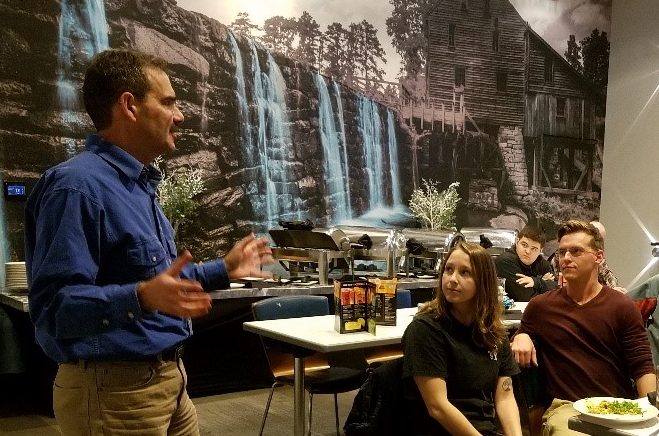
Faculty Advisor, Dr. Jim Rice, addressing members at our 2018 end-of-year celebration, reflecting on the time he has spent with the NCSU Student Fisheries Society.
The 2018 undergraduate travel award recipient was Austin Mueller, the equal opportunity award recipient was Riley Gallagher, and the graduate student travel award was Stephen Parker. The 2018 SFS EXCOM also made a notable change to the graduate student travel award. We renamed the award in honor of our faculty advisor, Dr. Jim Rice, who is retiring on January 1, and this was the inaugural award of the James A. Rice Graduate Student Travel Award. Thanks to Jim for his many years of service to the Student Fisheries Society!
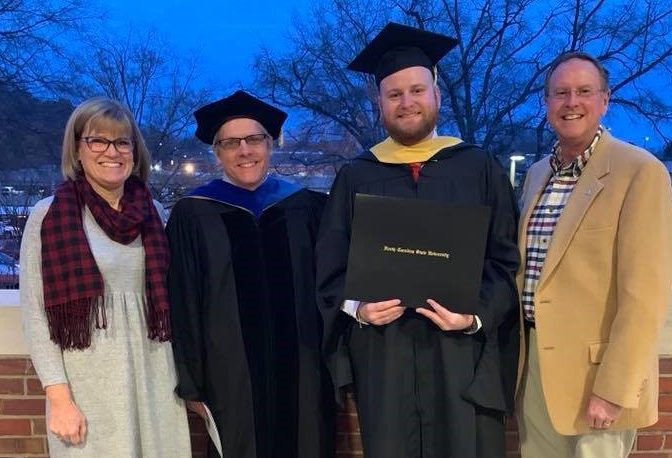
Freshly-minted fisheries Master and dedicated SFS member, Bobby Cope, with his advisor (and our new subunit faculty advisor!) Dr, Tom Kwak, and proud parents Jaimie and Greg Cope.
We held our primary fall-semester service event – clean-up of Rocky Branch Creek on NC State’s campus – on October 13 with several dedicated members. We’re now gearing up for our busy spring semester outreach activities, including Shad in the Classroom and Family Fishing Fiesta. To help fund all the work we do, we’re also gearing up for our annual raffle at the NCAFS 2019 meeting! We are actively collecting raffle items, so if you have something to donate, please contact incoming Co-Presidents, Jennifer Archambault ([email protected]) or April Lamb ([email protected]) and let them know! As always, remember to come prepared to buy tickets and win some amazing items and gear!
We will end with a couple of acknowledgements. One of our most active members over the last few years, Bobby Cope, successfully defended his Masters Thesis on the Carolina Madtom this semester and graduated December 19. He has moved on to Iowa State University to pursue a PhD. We extend many thanks to Bobby for his service! As we acknowledge service, we also thank the 2018 officers (Co-Presidents – Stephen Parker and Riley Gallagher, Secretary – Jennifer Archambault, Treasurer – April Lamb, and Undergraduate VP – Austin Mueller) for another great year. Finally, we welcome Dr. Tom Kwak as our new faculty advisor, and appreciate his continuing support of SFS and his willingness to serve in this role!
Submitted by Jennifer Archambault, Secretary, NCSU Student Fisheries Society
Environmental Concerns Committee Announcement
 As the premier fisheries professional organization in North Carolina, it is imperative that we use our expertise beyond our daily professional duties. The regulations in place for managing North Carolina’s natural resources change a bit each year, and with those changes comes an opportunity for the public to provide review and comment. One easy way for us to participate in maintaining and improving good fisheries practices in our state is to engage in this public process each year. On December 4, the NC Wildlife Resources Commission announced that the proposed 2019-2020 regulation changes were available for public comment. Opportunities for comment include public meetings and submission of online comments. The Environmental Concerns Committee (ECC) plans to review and comment on the proposed regulation changes to Inland Fishing in this and future cycles of regulation updates. We encourage all NCAFS members to review the proposed changes and participate in the public comment process available to all North Carolina residents. You can attend one of several public hearings in January or submit online comments directly to the NCWRC by the February 1, 2019 deadline. You may also bring any concerns to the attention of the ECC Chair by emailing Jennifer Archambault ([email protected]). The ECC is a small group, and we would appreciate hearing from members about their support or concerns so that NCAFS comments are reflective of views from the wider membership. Please send your comments to Jennifer no later than January 15, 2019.
As the premier fisheries professional organization in North Carolina, it is imperative that we use our expertise beyond our daily professional duties. The regulations in place for managing North Carolina’s natural resources change a bit each year, and with those changes comes an opportunity for the public to provide review and comment. One easy way for us to participate in maintaining and improving good fisheries practices in our state is to engage in this public process each year. On December 4, the NC Wildlife Resources Commission announced that the proposed 2019-2020 regulation changes were available for public comment. Opportunities for comment include public meetings and submission of online comments. The Environmental Concerns Committee (ECC) plans to review and comment on the proposed regulation changes to Inland Fishing in this and future cycles of regulation updates. We encourage all NCAFS members to review the proposed changes and participate in the public comment process available to all North Carolina residents. You can attend one of several public hearings in January or submit online comments directly to the NCWRC by the February 1, 2019 deadline. You may also bring any concerns to the attention of the ECC Chair by emailing Jennifer Archambault ([email protected]). The ECC is a small group, and we would appreciate hearing from members about their support or concerns so that NCAFS comments are reflective of views from the wider membership. Please send your comments to Jennifer no later than January 15, 2019.
Submitted by Jennifer Archambault, NCAFS ECC Chair
News from the NCAFS Awards Committee
UNDERGRADUATE STUDENT TRAVEL AWARDS AVAILABLE FOR 2019 NCAFS CHAPTER MEETING
To facilitate your participation in the Annual Meeting of the NC Chapter American Fisheries Society to be held February 19-21, 2019 in Winston-Salem, NC, travel awards are being offered by the NC Chapter. Support is provided via an award of $300 to help defer the costs of travel, registration, dues, and accommodations. A maximum of three travel awards will be made for the 2019 Annual Meeting. A complete application package must be submitted to Dr. W. Gregory Cope, NC AFS Awards Committee, Department of Applied Ecology, NC State University, Box 7617, Raleigh, NC 27695 on or before January 15, 2019.
See the Awards Committee web site for more details. Contact Dr. Greg Cope at [email protected] or at 919-515-5296, for more information.
CALL FOR NCAFS CHAPTER AWARD NOMINATIONS
The Chapter presents two awards on an as-warranted basis to recognize outstanding contributions by both chapter members and others. The Jerry R. Finke Distinguished Service Award recognizes Chapter members who have distinguished themselves by service to the Chapter, the AFS, or the fisheries profession. The Fred A. Harris Fisheries Conservation Award recognizes non-Chapter members who have distinguished themselves by service or commitment to the Chapter or the fisheries and aquatic resources of North Carolina. Please refer to https://nc.fisheries.org/awards/ or further descriptions and details of past winners.
The Awards Committee is soliciting nominations from the membership for both of these awards for 2019. If you are aware of a deserving individual or organization, please nominate them! Nomination letters should be no more than two pages long and provide specific information on the accomplishments of the candidates and why they qualify the candidate for the award. Qualifications for the Distinguished Service Award should extend beyond simply doing an outstanding job on regular chapter duties (e.g., officer or committee member responsibilities) and be based primarily on extraordinary efforts or new initiatives.
Please submit nominations to Greg Cope at [email protected]. Nominations will be accepted until Monday, January 21, 2019. If you have any questions, please call Greg at 919-515-5296.
Frank Joseph Schwartz Obituary
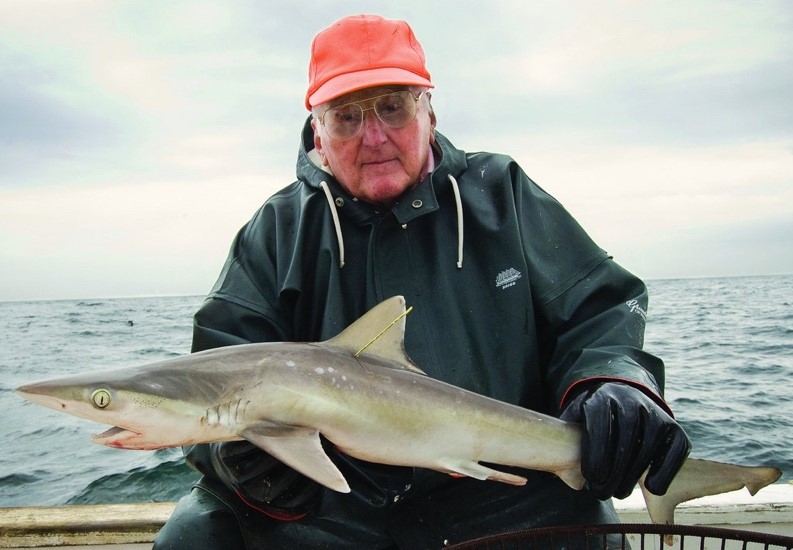
Frank Joseph Schwartz (1929-2018)
On November 26, 2018 Dr. Frank J. Schwartz passed away and the worldwide scientific community lost a longtime colleague. Dr. Schwartz was born in Pennsylvania and was very proud of coming from the part of that state that produced the noted ichthyologists Drs. Ernest Lachner and Edward Raney. He earned a master’s degree in Fisheries Biology and a doctoral degree in Ichthyology from the University of Pittsburgh. He joined the faculty of the UNC-Institute of Marine Sciences (UNC-IMS) in 1967 and spent his entire career there studying not only sharks and rays but also many other marine and estuarine species. Dr. Schwartz is noted for many things including: shark tagging efforts off of the coast of North Carolina which have lasted 47 years and are still ongoing; hundreds of publications, including many on sharks, skates, and rays; identifying Asian stingrays by their spines; and compiling a bibliography of hybrid fishes which he was working on at the time of his death. He regarded his six separate papers on the spines of stingrays of the world as his most significant contributions to the scientific community. In 2003, the UNC Press published Dr. Schwartz’s book—Sharks, Skates, and Rays of the Carolinas. His expertise on sharks attracted the attention of journalists and reporters, and articles about his work were featured in Our State magazine, in the Carteret County News-Times, and in Wildlife in North Carolina. Dr. Schwartz was honored by having an Asian ray ectoparasite named after him: Trimusculotrema schwartzi (Dyer, W. G. and W. J. Polly 2002. Trimusculotrema schwartzii n. sp. (Monogenea: Capsalidae) from the skin of the stingray Dasyatis zugei (Elasmobranchii: Dasyatidae) off Hong Kong, China. Systematic Parasitology 51: 217–225). He was also honored as Editor Emeritus of the Journal of the North Carolina Academy of Sciences, and recently, for his 50-year career at UNC-IMS as Professor and Curator of Fishes. Thank you to those that provided him with help and support: Glenn Safrit, Captain Joe and Ginni Purifoy, and Laura White.
In the mid-1970s, Dr. Schwartz supervised a multi-year intensive and extensive sampling of the lower Cape Fear River (CFR) estuary macrofauna – the beginnings of a long-term monitoring program, which continues to this day, on the environmental impacts of the Brunswick Nuclear Plant at Southport, North Carolina. Several publications resulted from that effort and perhaps more to come, especially regarding Atlantic Sturgeon recruitment in the Cape Fear River.
In 1996, the impressive collection of close to 18,000 lots of fishes that Dr. Schwartz curated at UNC-IMS was transferred to the North Carolina Museum of Natural Sciences (NCSM). A significant portion of this collection has been databased and the data are globally accessible via the museum’s online web portal. In October 2018, the Ichthyology Unit of the museum received a grant from the Institute of Museum and Library Services that will enable them to database the rest of the UNC-IMS collection. The global accessibility of this entire collection holds the potential for a vast amount of research of both high conservation and management importance, furthering the legacy of Dr. Schwartz.
Like many of us Dr. Schwartz loved doing field work rather than working in the laboratory or office. He often said: “need more field work” and relished being on the Harkers Island gillnet boat, the R/V Sarah Helen, for many field excursions during the CFR study. He enjoyed being surrounded by fishery students and assistants; many of whom have gone on to have very successful careers in their own right: George Burgess, David Fast, Peter Perschbacher, Fritz Rohde, Steve Ross, and Ken Sulak. Thanks, Frank, for your mentoring and many contributions over your lifetime.
Peter Pershbacher contributed to this obituary.
Telemetry Study Documents Atlantic Sturgeon Movement to Blewett Falls Dam
Telemetry has come a long way since its first fishery applications in the mid-1950s. Bulky transmitters with short battery lives, some lasting no more than 24 hours, gave researchers groundbreaking information on fish movement driving the field of biotelemetry. Not surprisingly, diadromous fishes were at the forefront of this research with analysis on salmon migrations (Trefethen 1956) and sturgeon passage in regions where hydroelectric structures were in place (Malinin and Svirskii 1973). Development of modern telemetry equipment enables a wide range of uses without its predecessor’s limitations and allows researchers to use standardized tools, essentially connecting coast wide arrays. Furthermore, advancements in battery technology allow the production of smaller transmitters with longer battery lives, some up to 10 years. Longevity of these transmitters permit insight into patterns that could not previously be documented, critical to understanding fish with long and complicated life histories. With life spans exceeding 50 years, Atlantic Sturgeon (Acipenser oxyrinchus) are among the longest lived fish inhabiting fresh waters on the Atlantic Coast, not reaching sexual maturity until the age of 8 to 20 years (ASMFC 1990, 1998). Atlantic Sturgeon are also among the largest fishes with females in South Carolina reaching about 2.5 m (8 feet) and males reaching about 1.8 m (6 feet) (McCord 2005, D’Ercole pers. comm.). Long-lived fish slow to reach sexual maturity are vulnerable to overfishing and take considerable time to recover from population declines. Historical coastwide population crashes led to Atlantic Sturgeon becoming listed as federally endangered by the National Marine Fisheries Service in 2012.
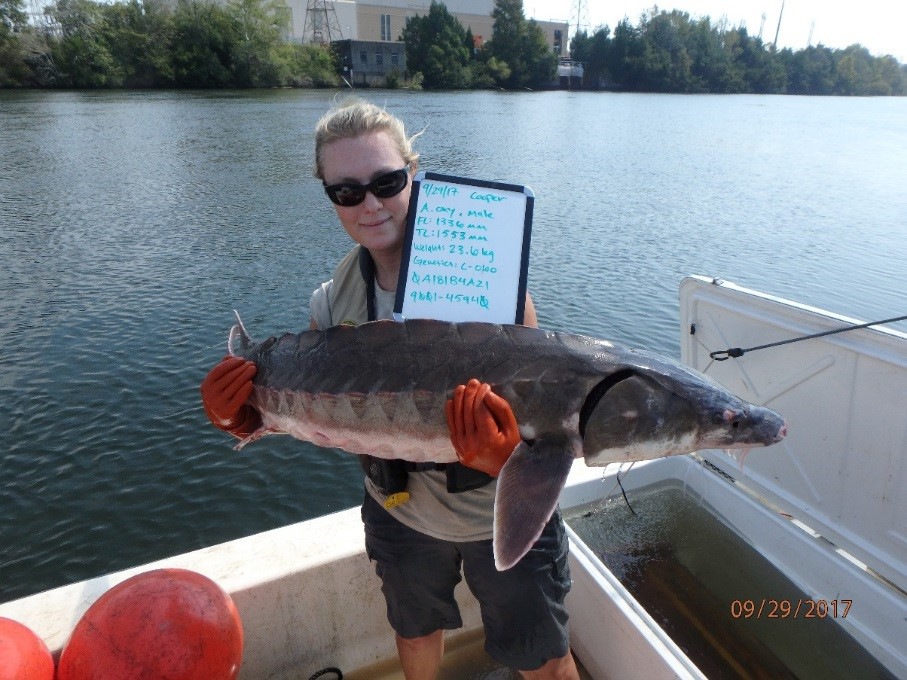
A male Atlantic Sturgeon captured from the Cooper River, SC. This picture is included by permissions granted under E.S.A. Section 10 (a) (1) (A) permit #20528.
Since 2010, the South Carolina Department of Natural Resources (SCDNR) has maintained an acoustic receiver array capable of detecting sturgeon tagged with transmitters throughout South Carolina. The Winyah Bay System array currently consists of 67 receivers in North Carolina and South Carolina. Receivers in the Great Pee Dee River extend from the mouth of Winyah Bay all the way to the Blewett Falls Dam (NC) covering 302 river kilometers. Until recently, there had never been any sturgeon detected past river kilometer 265. This observation supports the assessment that the Waccamaw Pee Dee Basin gives sturgeon access to a large percent of their historical range of spawning and early nursery habitat originally described by Mills in 1862, pre-dam (McCord 2005). Mills (1862) noted that further inland passage would only be successful given high flows because of small rapids near the South Carolina fall-line, allowing over 200 km of easily navigable waters for these large fish. New evidence from the fall of 2018 appear to support these previous assumptions. A male Atlantic Sturgeon, originally captured and tagged at Pinopolis Dam in the Cooper River, SC, in September 2017, left the Charleston Harbor in May, 2018. He travelled north along the coast entering Winyah Bay, and remained there until late August when he began his ascent up the Great Pee Dee River for a presumed spawning run. By September 9, he was located at river kilometer 190, an area close to that which is usually the terminus of the long migration. Ten days later, this fish was detected at the Blewett Falls Dam, NC, at river kilometer 302. He remained in this upper reach of the river before heading back downriver in mid-October. His last detection was on October 26, near river kilometer 34. This was an unprecedented event and is believed to coincide with the impacts of Hurricane Florence. Given the circumstances of this fish’s long migration upriver and it being an isolated event, it’s hard to draw any conclusions, however, it is another reminder of how little we know about these ancient fish and the significance of ongoing telemetry studies.
Every Atlantic Sturgeon tagged helps develop a better understanding of their range, life history, and critical habitat use, all information crucial to the conservation of the species. Although the technological advances in telemetry are impressive, the quality of the science depends on the collaboration of the researchers interpreting these data. SCDNR will continue their tagging efforts, monitoring the array, and communicating with their peers eager to gain more insight on this species.
Editor’s Note: At least two large Atlantic Sturgeon were caught in the North Carolina portion of the Pee Dee River in the early 1950s. The above record is the first one since then (Tracy et al. Unpublished manuscript).
Literature Cited
ASMFC. 1990. Fishery management plan for Atlantic sturgeon. Atlantic States Fisheries Commission Fisheries Management Rep. No. 17. 73 pp.
ASMFC. 1998. Amendment 1 to the interstate fishery management plan for Atlantic sturgeon. Atlantic States Fisheries Commission Fisheries Management Rep. No. 31. 43 pp.
Malinin, L. K. and A.M. Svirskii. 1973. Application of biotelemetry to ichthyology. Translated by Fisheries Research Board of Canada 2707 (in Russian).
McCord , J. W. 2005. Sturgeons. http://www.dnr.sc.gov/cwcs/pdf/Sturgeon.pdf.
Raskin, H. (2015, June 23). Sturgeon caviar industry once thrived in South Carolina. Post and Courier. Retrieved from https://www.postandcourier.com
Trefethlen, P.S. 1956. Sonic equipment for tracking individual fish. U.S. Fish and Wildlife Service Special Science report. Fisheries 179:1-11.
Submitted by David Hood, South Carolina Department of Natural Resources
Other Notable Recent Atlantic Sturgeon Records
Neuse River
On April 17, 2018, North Carolina Wildlife Resources Commission biologists Ben Ricks and Courtney Buckley observed an Atlantic Sturgeon while collecting Neuse River Striped Bass broodfish via electrofishing. The fish was approximately 8 to 9 ft in length. As soon as the fish was observed, electrofishing efforts ceased, and the fish quickly swam out of view. The fish was observed in the Neuse River Cut Off near Goldsboro at approximately (35.3499088°, -78.031729°). This is the furthest upstream documented occurrence of this species in the Neuse River.

Dead young-of-the-year Atlantic Sturgeon observed after Hurricane Florence. Photo: Joe Facendola NCDMF
Cape Fear River
As part of International Paper’s long-term dioxin fish tissue monitoring in the Cape Fear River, CZR Incorporated staff, including Mark Westendorf and his co-worker, were setting out gill nets at one of their sites in mid-September 2016, just upstream of Elwell’s Ferry (above Lock and Dam No. 1). As they picked up the gill nets on Tuesday, September 20, 2016 at 11 am, a 5 ft Atlantic Sturgeon was slightly tangled in one of the nets. Mark inspected the fish for tags and/or surgical evidence and none were found. The fish seemed in good health when released to the water. The US Army Corps of Engineers (USACE) had ceased locking operations at Lock and Dam No.1 because there is a rock arch fishway, completed in 2013, at the base of the dam built specifically for fish passage. In late August 2014 a large sturgeon was observed breaching below Lock and Dam 2 but since the USACE was still locking at No. 1 it is uncertain which route this fish took at No. 1.

Dead adult Atlantic Sturgeon observed after Hurricane Florence. Photo: Fritz Rohde
In the aftermath of Hurricane Florence in September 2018, at least 12 dead Atlantic Sturgeon were found in the Cape Fear River and adjacent areas. A large, approximately 5-ft adult was observed at Lock and Dam No. 1 and six subadults (and possibly one young-of year) were found on the beach at Oak Island. Roanoke River Following Hurricane Florence, a large 6-ft, 22 pound, gravid female full of eggs was found dead in the Cashie River.
Submitted by Fritz Rohde, NOAA National Marine Fisheries Service
News from NCWRC
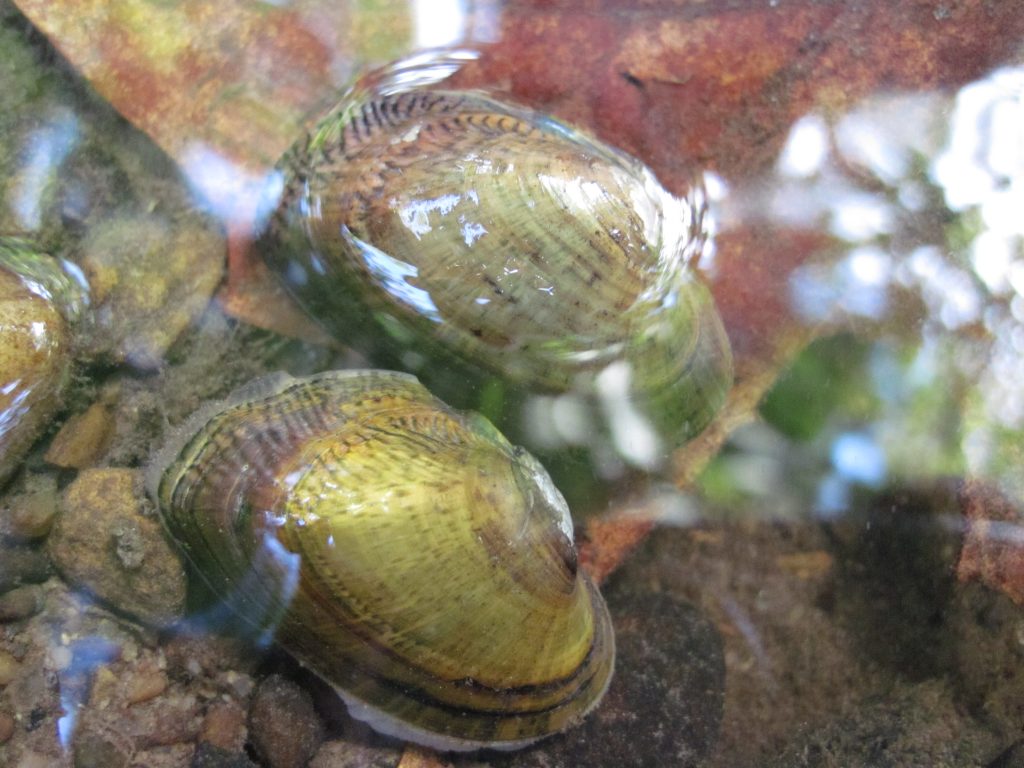
Juvenile Brook Floaters
Wildlife Diversity Program Quarterly Reports
NCWRC’s quarterly wildlife diversity reports contain updates on a wide variety of nongame research projects and survey results. This issue includes an update on aquatic species monitoring in Lake Waccamaw, along with Spotfin Chub, freshwater mussel, and Lake Sturgeon projects.
Call to Action!
If you want to contribute, have a story idea or would like us to include something in next quarter’s newsletter, email Kevin Hining [email protected] or give him a call at 336-213-9692.
Also, if you want to become more involved with one of the many great NCAFS committees then please check this link for information about each one, contacts, etc., https://nc.fisheries.org/who-we-are/committees/
 Valuable Links
Valuable Links
The American Fisheries Society Home Page offers a wealth of links to assist you in your fishy endeavors. Information on ordering AFS books, public outreach, annual meetings, chapter links and joining the AFS can be found there.
This and archived NCAFS newsletters, along with links, chapter information, and upcoming meetings, can be found here on our own website.
